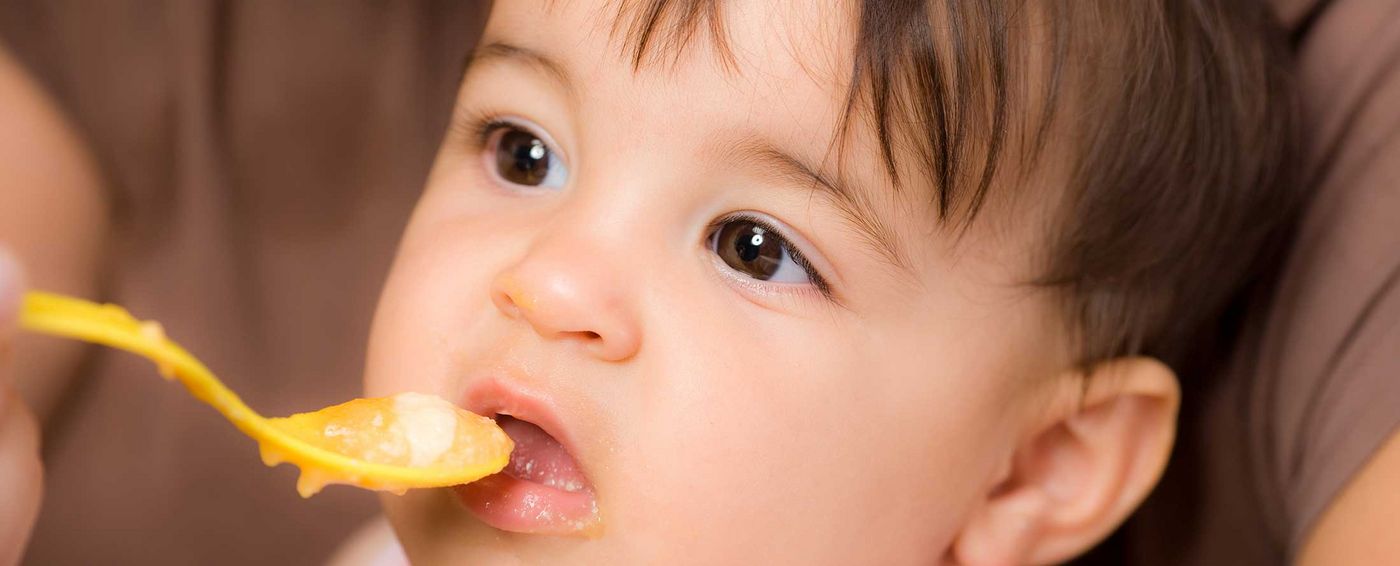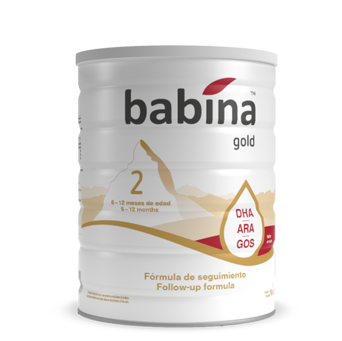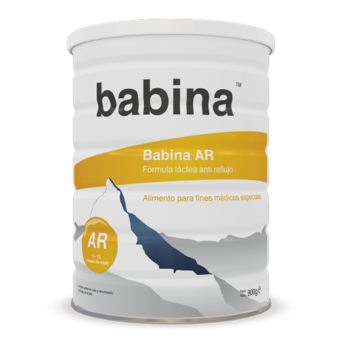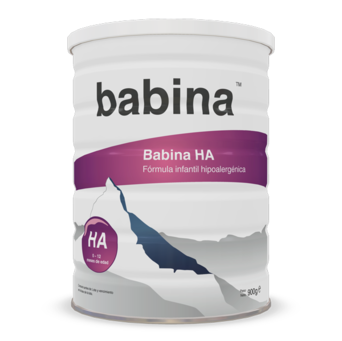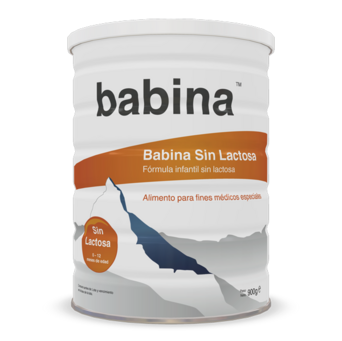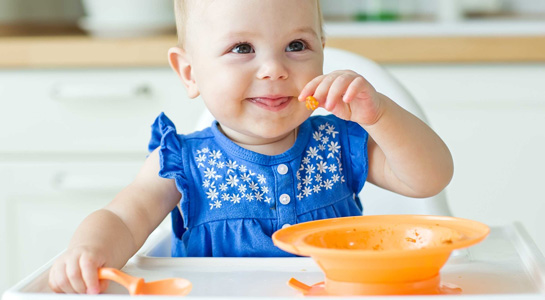
When you start to give your baby foods other than breast milk, it is called weaning or complementary feeding. Weaning usually begins around six months of age but all babies develop at different rates and some children wean themselves earlier than others. Do not start weaning before four months, as your baby's digestive system will not be fully mature for the first few months.
Signs for initiating weaning
These may all be signs that your baby is ready to move on to the first weaning foods:
- Hungrier than usual (even after a milk feed).
- Smacking the lips or exploring objects with the mouth.
- Waking in the night despite sleeping through previously.
- Controlling the head movements well when in a sitting position.
Infants offered a variety of vegetables during the first weeks of weaning are more willing to try, accept and like new vegetables – it makes them more likely to enjoy unfamiliar varieties.
Weaning process
The process of weaning is most successful if it occurs gradually, naturally and calmly.
- The proportion of solid foods gradually increases whilst the amount of breastfeeding and/or formula feeding decreases.
- If you are breastfeeding, feed on demand as well as offering food. As a general guide, formula-fed babies need around 500 to 600 ml of formula a day.
- When you are formula feeding: a follow-on formula is suitable for babies who are six months and older. A follow-on formula can also be used as a milk drink and to prepare other foods, such as cereals.
Helpful tips for switching to solid foods
babina has put together some few useful tips to help your baby enjoy the weaning phase and the switch to solid foods.
The introduction of foods
The introduction of foods is an important step in your baby’s development and it can be great fun to explore new flavours and textures together. In this first half year, your baby’s birth weight has doubled and they are physically ready for other foods to meet their growing nutritional needs. Breast milk (and/or a formula) is still your baby's main source of nutrition and solid foods help to top up some essential nutrients for your baby.
During the weaning period, babies learns how to chew, swallow and even how to feed themselves. Weaning is necessary for both nutritional and developmental reasons and to enable the transition from milk feeding to family foods.
- Your baby does not need three meals a day for a start, so you can begin by offering foods at a time that suits you both. How much your baby eats is less important to begin with than introducing the idea of eating.
- Gradually, you will be able to increase the amount and variety of food your baby eats. At the end of this whole process, your child will eat, more or less, the same as the other family members.
Teething
From approximately 6 months onwards, the primary teeth start to come in (erupt). The time of eruption varies from child to child but most children have a full set of primary teeth by the time they are 3 years old: 12 teeth and 8 molars. These primary teeth are susceptible to decay as soon as they appear in the mouth. Tooth decay in infants and toddlers is called ‘early childhood caries’.
- When your baby‘s first tooth erupts, begin cleaning the teeth with a soft washcloth or small, soft toothbrush with a tiny smear of (toddler) toothpaste. Ask your dentist for advice.
- Never allow your infant or toddler to fall asleep with a bottle containing milk, formula, fruit juice or sweetened liquid and do not dip a pacifier in sugar or honey.
- If your infant or toddler needs a comforter between regular feedings or at bedtime, give the child a clean pacifier.
The first foods
Let your baby enjoy touching and holding the food. It is fun to allow children to feed themselves, using their fingers, as soon as they show an interest. Don't force your baby to eat – just wait until the next time and keep trying. Babies and toddlers are more likely to try new foods than older children. When you are using a spoon, your baby may like to hold a spoon, too. Start by offering just a few pieces or teaspoons of food once a day and don’t add sugar or salt.
Ask your health care practitioner or local health centre for advice.
Vegetables and fruits are ideal first weaning foods for your baby. Some foods are easy to mash or puree when raw; others need to be cooked first.
- For example carrots, green peas, parsnip, broccoli and cauliflower. If your baby isn’t keen on the taste you can mix these with sweet-tasting vegetables like sweet potato.
- Mashed banana, avocado, pear or cooked apple or soft, ripe fruit, such as peach or melon (mashed or sliced into fingers).
You can also introduce baby rice or baby cereal made with breast milk or formula. This can be offered on its own or mixed with pureed fruits or vegetables. Think of a nice combination.
First weaning steps
Here are some tips – but follow your own instinct:
- Introduce new foods when your baby is relaxed and happy, for example mid-morning.
- Do not introduce new foods when your baby is hungry for milk or too full after a milk feed.
- Offer small amounts of a new food and increase the amount gradually.
- Show your baby that you are enjoying a variety of foods too.
- Be creative with mixing-up new foods.
- Explore different ways to cook. Just try it out; mash, boil or roast and see the different texture, taste, colour and size.
- Don't force your baby eat a new food. Simply wait until the next time and keep trying.
The next weaning steps
Once your baby is used to the foods above, they can have soft, cooked, pureed meat, fish (check very carefully for any bones), pasta, noodles, rice, (hard-boiled) eggs or lentils. This way your child will discover new flavours every time.
General recommendations:
- Whole cows’ milk should not be used as the main drink before 12 months of age.
- Avoid sugar-sweetened beverages; such as fruit juices with added sugar.
- Do not add salt and sugar.
- Honey should not be introduced before 12 months of age.
- Avoid whole nuts.
About iron
The mineral iron is required to produce blood. It is needed to make haemoglobin, the protein in red blood cells that carry oxygen around the body. Iron is also important to provide the growing muscles with oxygen and it helps to support your baby’s rapidly developing brain. After birth, your baby's iron stores are sufficient for the first six months. Iron-rich foods are an essential part of the weaning diet because breast milk provides an insufficient supply to meet your baby’s growing needs. A follow-on formula is specially formulated for infants of 6 months and older and is enriched with iron – helping to meet daily iron requirements. Too little iron can lead to iron deficiency anaemia – a condition that can affect your baby’s (brain) development.
Iron-rich foods (prepared as advised) to increase your baby’s intake:
- Meat, poultry and oily fish, such as sardines and salmon
- (Hard-boiled) egg
- Dark green, leafy vegetables like spinach, collards and kale
- Beans and other pulses like lentils
- Dried fruits such as raisins, prunes, dates, and apricots
- Fortified cereals
Adding foods that have vitamin C to an iron-rich meal can help boost absorption – for example, adding some orange slices or other fresh fruits.
From bottle to cup
Most babies are ready to start drinking from a sippy cup between 6 and 9 months. By the time babies are one year old, they should have stopped using bottles with teats. Otherwise, it may be hard to break the habit of comfort sucking on a bottle.
- Start with a slow-and-easy approach, replacing one regular bottle fee (breast milk or formula) with a sippy cup. Do this every few days until you are completely bottle-free.
- Turn the milestone into a celebration and help your child understand that they are getting bigger.


